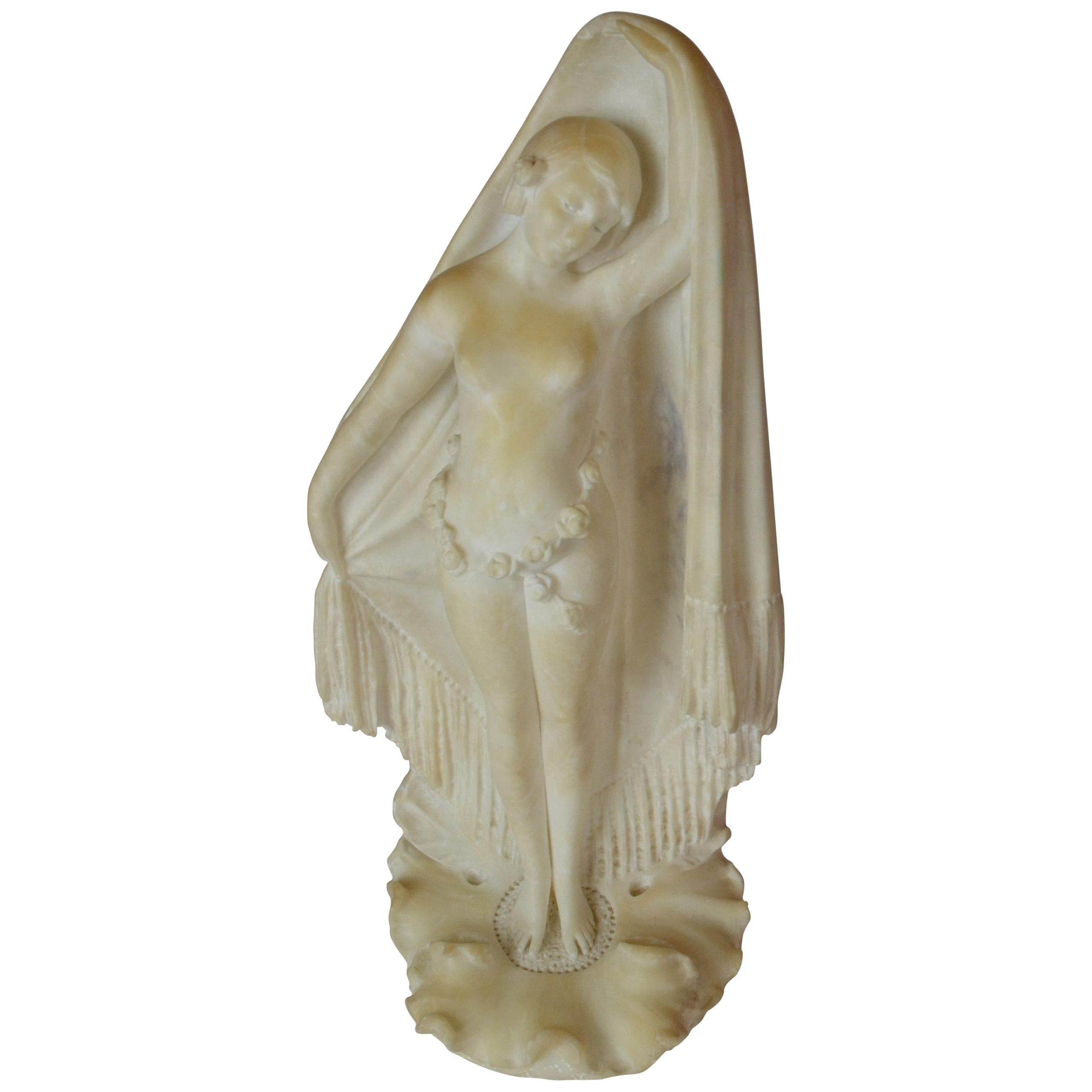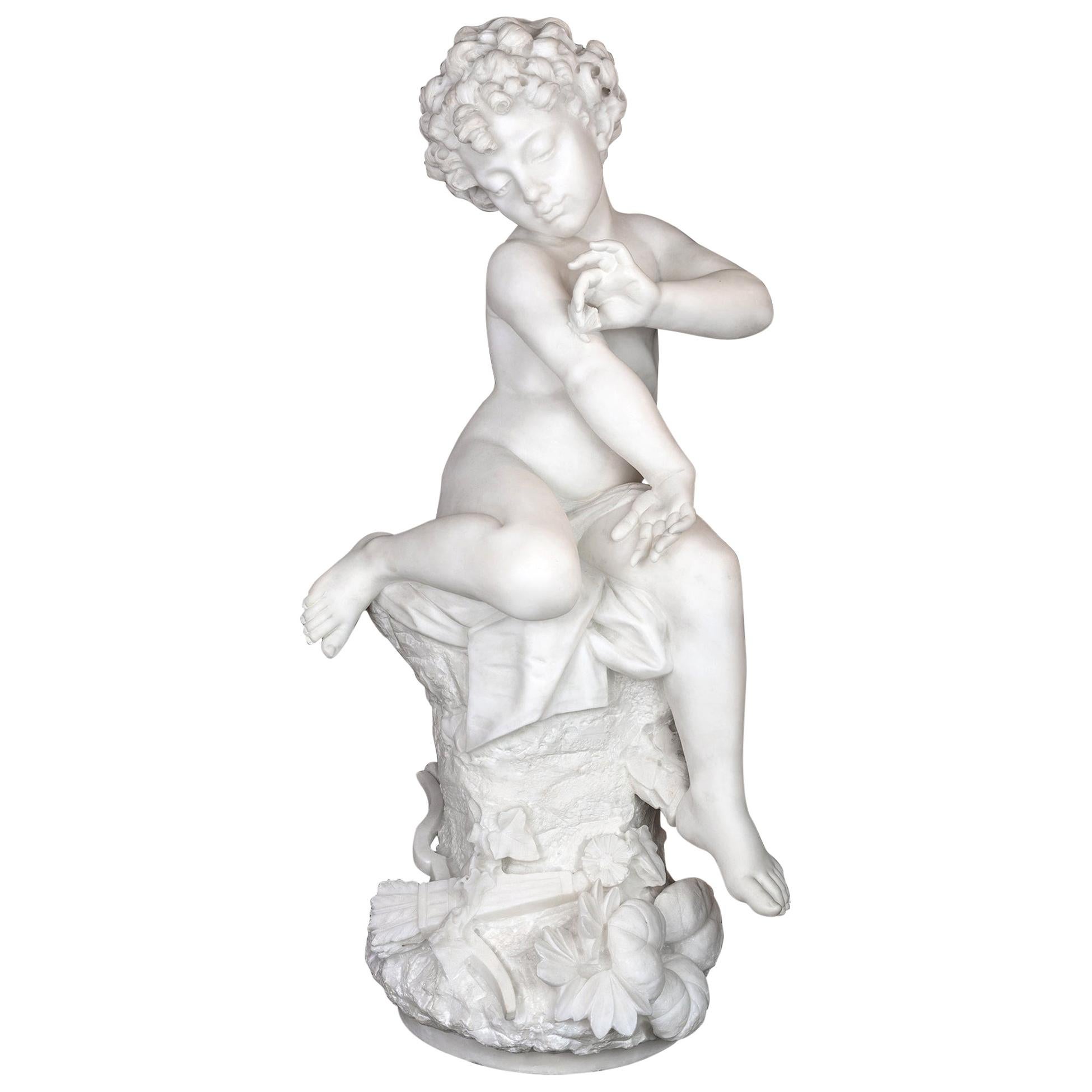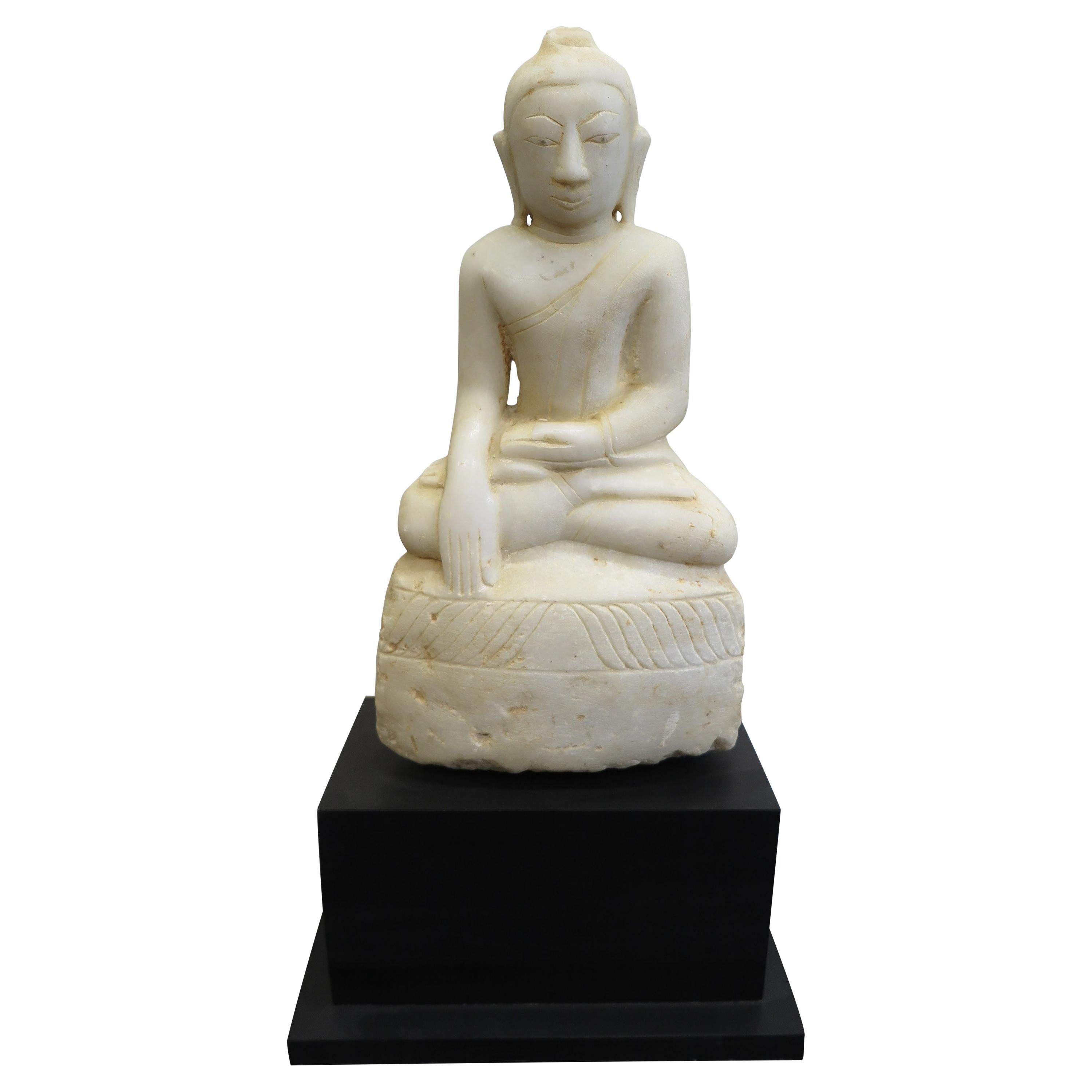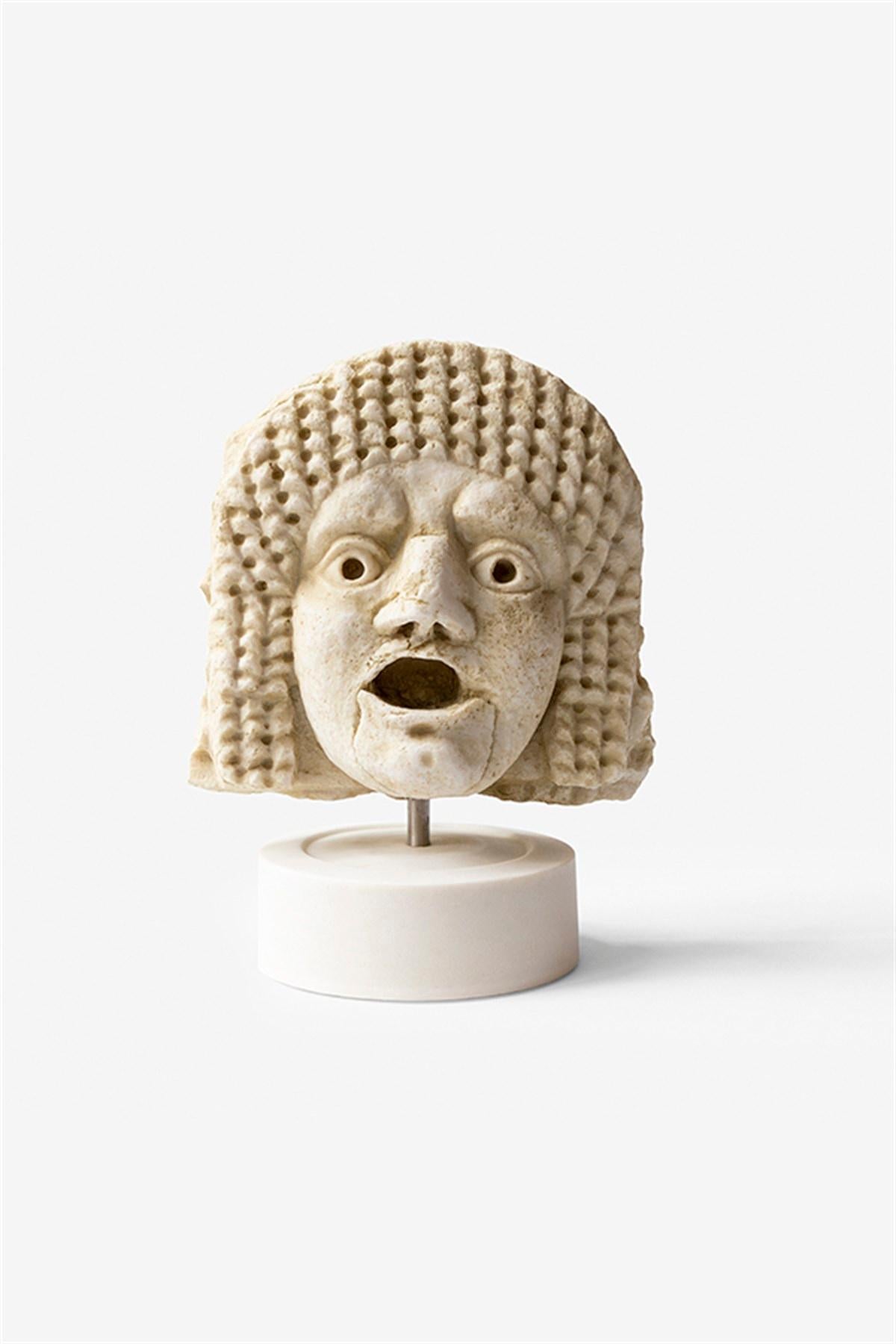Items Similar to Ancient South Arabian Alabaster Statue
Video Loading
Want more images or videos?
Request additional images or videos from the seller
1 of 9
Ancient South Arabian Alabaster Statue
About the Item
South Arabian Calcite female figure
3rd Century BC to 1st century A.D.
Calcite Alabaster
height: 30.5 cm
A magnificent alabaster female figure, a fine example of the well-studied grace that characterises South Arabian art. The figure is standing with extended arms and clenched fists, the sensitively carved face exudes power and mystery, with large, almond-shaped eyes, sweeping eyebrows, straight nose, and gently smiling lips.
The South Arabian kingdom of Qataban rose to prominence in the fourth century BC. Its capital, Timna - according to Pliny the Elder, adorned with 65 temples - was an important stop along the incense trade route, thanks to which it became an extremely prosperous and sophisticated economic and cultural centre. The style of the present figure suggests it comes from Haid bin Aqil, Timna’s necropolis, where some of the greatest treasures of South Arabian art have been discovered. Qatabanian sculptors were greatly skilled, and well known for the subtlety and elegance of their designs. Their strikingly modern figures fascinated and inspired some of the most important artists of the early twentieth century, including Pablo Picasso and Amedeo Modigliani.
Complete figures of this type with an original surface and documented provenance very seldom pass into private hands; this piece represents not only a superb piece of ancient sculpture, but a real rarity on the art market today.
Provenance:
Probably from Haid bin Aqil, the necropolis of ancient Timna
French private collection, Aden and Paris, acquired in Yemen in the 1960s and legally exported to France. With French cultural property passport.
Published:
Yémen, Au pays de la reine de Saba, p. 100
Sabina Antonini, La statuaria sudarabica in pietra, Paris and Rome, 2001, p. 112.
- Dimensions:Height: 12.01 in (30.5 cm)Diameter: 4.49 in (11.4 cm)
- Materials and Techniques:
- Place of Origin:Yemen
- Period:
- Date of Manufacture:3rd Century BC-1st Century A.D.
- Condition:Wear consistent with age and use.
- Seller Location:London, GB
- Reference Number:
About the Seller
5.0
Recognized Seller
These prestigious sellers are industry leaders and represent the highest echelon for item quality and design.
Established in 2008
1stDibs seller since 2014
100 sales on 1stDibs
Typical response time: 7 hours
Associations
LAPADA - The Association of Arts & Antiques DealersInternational Confederation of Art and Antique Dealers' AssociationsThe British Antique Dealers' Association
- ShippingRetrieving quote...Ships From: London, United Kingdom
- Return PolicyA return for this item may be initiated within 14 days of delivery.
More From This SellerView All
- Ancient South Arabian Alabaster InscriptionLocated in London, GBSouth Arabian Alabaster Inscription Calcite Alabaster circa 1st century A.D. ‘’Consequently, neither white marble of Paros nor any other stone which men admire can be compared with the precious stones of Arabia, since their whiteness is most brilliant, their weight the heaviest, and their smoothness leaves no room for other stones to surpass them.’’ - Diodorus Siculus, Library of History, Book II, 52.9 This inscription, finely worked on an alabaster tablet, is a remarkably well preserved example of Ancient South Arabian script, with its distinct bold, angular forms, written in the Qatabanic dialect - that is, the dialect spoken by the people of the kingdom of Qataban, which ruled much of modern day Yemen from the 7th Century B.C. to the 2nd Century A.D. The text, which reads: ‘[... ...]sa?d and Ma?add?i- / (of the lineage) of Hawfa- / She entrusted Anb- / against any malfeasance (which would remove it) from its place’ - indicates that it likely served to commemorate a temple offering. The quality of the script, incised so neatly into the surface of the alabaster, tells us that this piece was commissioned by somebody of considerable wealth and prestige, employing a scribe of equally considerable expertise. South Arabia was known throughout the ancient world for its incredible wealth - so much so that the Romans termed the region ‘Arabia Felix’ - literally, ‘Happy, or Fortunate, Arabia.’ That wealth was built largely on the trade of spices and incense, in which the Kingdom of Qataban played a major part. According to Pliny the Elder, this was the sole country through which frankincense could be exported, first being collected in the city of Shabwa, on the South Arabian coast, and from there travelling by camel up to Gaza, to be shipped all across the Mediterranean - not only that, but all growers of myrrh across Arabia were required to give a quarter of their yield to the king of the Qatabanians. As such, the kingdom became exceedingly rich and powerful, and Pliny goes on to tell us that ‘The nations of the Larendani and the Catabani, and the Gebanitæ [...] occupy a great number of towns, the largest of which are Nagia, and Thomna (the capital of Qataban) with sixty-five temples, a number which fully bespeaks its size.’ Because of the nature of its exports, frankincense in particular - the ‘sweat of of the gods’ according to the Egyptian Book of the Dead, and perhaps most famous as one of the three gifts brought to the newborn Christ - being closely associated with the divine, South Arabia’s reputation in antiquity was as a mysterious, almost sacred, and - crucially - extraordinarily wealthy region, at the very edge of the known world; in the words of Herodotus: ‘’Enough of marvels, and yet the land of Arabia gives off a scent as sweet as if divine.’’ This inscription invokes the protection of god Anbay, the judge-oracle of the chief god ‘Amm, who he served as an attendant. Much of what we know of the religious life of the ancient South Arabians comes to us from early Islamic texts, describing what is known in Islamic scholarship as ‘Jahiliyyah’ - the age before the advent of Islam in Arabia. What comes across in much of these texts is that these religious practices placed a great deal of emphasis on sacred stones, perhaps linked to the brilliance of the alabaster which is local to the region, and which a great many of the cult-objects produced in this time are made from. Hisham ibn-Al-Kalbi’s Book of Idols records: ‘’The Arabs were passionately fond of worshipping idols [...] Whenever a traveller stopped at a place or station in order to rest or spend the night, he would select for himself four stones, pick out the finest among them and adopt it as his god, and use the remaining three as supports for his cooking-pot.’’ This inscription was once in the collection of the intrepid British-Australian travel...Category
Antique 15th Century and Earlier Yemeni Abstract Sculptures
MaterialsAlabaster
- Ancient Greek Corinthian HelmetLocated in London, GBCorinthian helmet with Bull Horns and Lotus Flower Decoration. Archaic Period, c.550-500 BC. Cast, hammered and incised bronze. An exceptionally well preserved example of one of the most iconic ancient Greek...Category
Antique 15th Century and Earlier European Classical Greek Mounted Objects
MaterialsBronze
- Ancient Egyptian Monumental Temple SphinxesLocated in London, GBA pair of monumental limestone sphinxes of Pharaoh Nectanebo I, from the processional avenue of the Serapeum of Memphis, 30th Dynasty, circa 379 - 360 BC. The sphinxes of the Serapeum have captivated travellers since Roman times. However, despite their significance, they are conspicuously absent from the collections of most major museums. Indeed, their existence in private hands is so improbable, and their imitations so numerous, that the present sphinxes were assumed to be modern copies throughout their recent ownership history. Finally recognised and conserved after an extraordinary chance discovery at a garden furniture sale...Category
Antique 15th Century and Earlier Egyptian Egyptian Figurative Sculptures
MaterialsLimestone
- Ancient Silver Celtic Tetradrachm CoinLocated in London, GBCeltic ‘Dachreiter’ Tetradrachm Minted in Eastern Europe, circa 1st-2nd Century B.C. Silver A magnificent Celtic tetradrachm of the Dachreiter (“roof-rider”) type, minted by a C...Category
Antique 15th Century and Earlier Mounted Objects
MaterialsSilver
- Ancient Greek Hellenistic Bronze Statuette of SatyrLocated in London, GBBeautifully cast statuette of a satyr, Greek, Hellenistic Period, 3rd-2nd Century BC, solid cast bronze The present work is a wonderful example of the finest Hellenistic style. The ...Category
Antique 15th Century and Earlier Greek Classical Greek Figurative Sculpt...
MaterialsBronze
- Ancient Greek Perfume BottleLocated in London, GBAthenian Black-glaze perfume pot with inscription Athens, c. 425-400 B.C. Terracotta Measures: Height: 9cm; diameter across lip: 7.5cm; width including handle: 9cm This 5th Cen...Category
Antique 15th Century and Earlier Italian Classical Greek Bottles
MaterialsPottery
You May Also Like
- Medieval English Alabaster StatueLocated in Wormelow, HerefordshireA medieval English alabaster statue, possibly dating as far back as the late 14th / early 15th century, mounted on one of our exclusive large display plinths. Well weathered over the centuries, this 600-year-old statue depicts a medieval cloaked figure, possibly a monk, offering a glimpse into English architecture and sculpture of the Middle Ages. This sculpture is possibly made from Nottingham alabaster. During the 14th and 15th centuries, Nottingham was the centre of alabaster carving and painting. Alabaster works were mostly made as small alabaster models with religious themes. During the 16th century Reformation, many alabaster carvings were destroyed under King Henry VIII's rule, making any surviving examples even more significant. Provenance From the collection of Peter Hone (b. 1941). A master plaster caster, he is an expert and experienced collector, building up an extraordinary, museum-worthy collection of items in his one-bedroom flat in London W11...Category
Antique 15th Century and Earlier English Medieval Figurative Sculptures
MaterialsAlabaster
- Italian Alabaster Statue of a GirlLocated in Pomona, CAItalian alabaster statue of a young girl.Category
Vintage 1920s Italian Figurative Sculptures
MaterialsAlabaster
- Alabaster Sculpture Statue of CupidBy William-Adolphe BouguereauLocated in New York, NYA fine quality alabaster sculpture of cupid with a butterfly. Nude figure of cupid with a butterfly, sitting on a rock, his bow and arrow on the ground with the flowers. Artist: After William Adolphe Bouguereau...Category
Antique Late 19th Century French Figurative Sculptures
MaterialsCarrara Marble
- Buddha Statue 19th Century AlabasterLocated in New York, NY18th/19th century Buddha Statue carved of Alabaster. Burmese Shan Buddha Statue 1800ca, collected in Myanmar Shan State 1998. Legs crossed, the left hand in the lap, and the right ha...Category
Antique Early 1800s Burmese Figurative Sculptures
MaterialsAlabaster
- Ancient Roman Theathre Mask Myra No:2 StatueBy LAGULocated in İSTANBUL, TRIt was found in the ancient city of Myra in Antalya, Turkey. It was used as a mask in theaters during the Roman period. The city of Myra, one of the six most important cities that w...Category
2010s Turkish Classical Greek Busts
MaterialsStatuary Marble
- 19th Century Orientalist French Bronze Statue of Arabian WarriorLocated in New York, NYLarge patinated bronze figure of a proud Middle Eastern male. Signed in the cast, Koenig with Patent 1888 Paris. Apparently designed as a stick stand.Category
Antique Late 19th Century French Figurative Sculptures
MaterialsBronze





